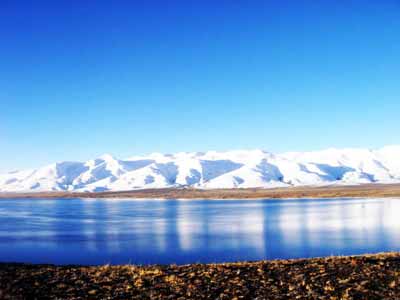| Home / China / Sci&Tech / Photos | Tools: Save | Print | E-mail | Most Read |
| Global Warming Threatens Plateau |
| Adjust font size: |
The environmental condition of the Qinghai-Tibet Plateau, seen as a barometer for the world's health, is worsening due in large part to global warming, according to a geological survey.
The survey, conducted by the Remote Sensing Department of the China Aero Geophysical Survey, showed the plateau has shrinking glaciers, a rising snow line, dwindling wetlands, and more serious desertification compared with 30 years ago. The Qinghai-Tibet Plateau, which accounts for nearly one quarter of China's landmass, stretches into the Tibet Autonomous Region, Qinghai, Sichuan and Yunnan provinces and the Xinjiang Uygur Autonomous Region. It is the highest and youngest plateau in the world and has been dubbed "the third pole." It is also home to the source of many big rivers in Asia, such as the Yangtze, Yellow and Lancang rivers, giving it the nickname the "water tower" of China. "As the 'thermometer' of the global environment, any slight environmental change in the plateau is a reflection for the globe," said Zhang Hongtao, deputy director of the China Geological Survey. The survey, which used remote sensor technology, is intended to provide an overview of the plateau's geological conditions and help its future economic development, Zhang said. "The direct harm is the threat of the loss of the country's fresh water resources," said Fang Hongbin, senior engineer at the Remote Sensing Department. "Furthermore, we won't have any shield to protect ourselves from the sand blowing from the plateau if the desertification trend is not checked." Fang suggested speeding up a project called "return the land to green" in the western part of the country, as well as strictly controlling the raising of livestock and mining activity on the plateau. Even if the world's global climate does not continue to get warmer, researchers estimate the plateau's glacial areas will shrink to 72 per cent of the current area by 2050 and 50 per cent by 2090, Fang said. "The melting of the glaciers and snow has provided huge water resources for the plateau and its surrounding area and led to a temporary increase of wetlands and lakes in some regions," said Fang. "But with the constant decrease of glaciers and the raising of the snow line, the total water reserve of the plateau keeps declining." The glaciers on the plateau show an obvious trend of diminishing, especially on the edge of the plateau. The trend has gained momentum in recent years, the survey showed. The snow line on the edge of the plateau also saw drastic reduction, with an average retreating distance of 100 to 150 metres, with the largest being 350 metres. Although the desert region of the area is just slightly changed, areas of medium and heavy desertification saw a huge increase, which means more desertification in the future. (China Daily January 2, 2007) |
| Tools: Save | Print | E-mail | Most Read |
 |
| Related Stories |
|
